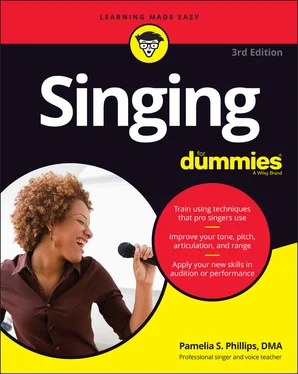Some performers are really amazing onstage — obviously having fun — and they also have great technique. Check out Chapter 21to see whether any of your favorite singers made my list of performers with great technique. And if you want your performance to be spectacular, Chapter 24has some great tips on performing like a pro. Before your big performance, check out Chapter 22for answers to the most commonly asked questions about singing, and see Chapter 23for information on keeping your voice healthy. Maintaining a healthy voice is important. Your vocal cords are really small, and you want to take good care of them. You can also read about medications and other factors that influence your singing voice. A healthy voice and solid technique will keep you singing for years to come.
The online tracks at www.dummies.com/go/singingfd3e that come with the book are a great tool to help you keep polishing your technique. The singers on the files have two things in common with you:
They all love singing.
They all have a group of exercises they use to keep their technique in tip-top shape.
You may think that only classical singers have a vocal workout routine, but that’s not true. Some famous singers even post videos of themselves practicing before they walk out on stage and sing their pop-rock tunes. Check out the different singers on the tracks that range from a rapper, belters, pop singers, musical theater performers, classical singers, and different voice types of all shapes and sizes to see if you can tell what style of music they perform.
You may be surprised that the type of singer isn’t always obvious just by listening to them warm up. Before and after recording the tracks, each singer laughed a lot and experienced the challenge of demonstrating a specific sound just for you.
Chapter 2
Determining Your Voice Type
IN THIS CHAPTER
 Understanding the highs and lows of voice types
Understanding the highs and lows of voice types
 Discovering the voice type categories
Discovering the voice type categories
 Finding out where you fit in
Finding out where you fit in
Finding your voice type is a challenge because several ingredients combine to create a voice type. You don’t have to know your voice type if you’re singing for your own enjoyment, but you may be curious to find out. If you aspire to sing professionally or do some professional auditions, you definitely want to know your voice type. You’ll be asked at the audition, so you want to know that answer before someone asks. Chapter 20has more info about auditions.
Determining your voice type — soprano or mezzo-soprano for women, tenor or bass for men — enables you to choose songs that are most appropriate for you. After you figure out what category you fit into, check out Appendix Afor a list of songs suitable for your voice type. Read on to explore how each voice type sounds and how to determine where your voice fits.
Sifting through the Ingredients to Figure Out Your Voice Type
Think of a voice type as a series of ingredients mixed together to create a unique-tasting dessert. For singing, the ingredients combine to create a unique-sounding voice. The four common voice types are soprano, mezzo-soprano (often called mezzo), tenor, and bass (the next section, “ Identifying the Fab Four,” tells you all about these four voice types). These five ingredients determine a voice type:
Age: Many singers are assigned a voice type as young singers, but voices change with age. The muscles in the larynx continue growing and developing into the early 20s. Think about the last time you made a phone call and heard the sound of a stranger’s voice. Even if you didn’t know the person on the other end, you could guess their age by listening to their speaking voice. Because speaking voices and singing voices change with age, wait until your body is finished growing to determine your voice type.
Range: Range is all the notes a singer can hit — including the highest note, the lowest note, and all the notes between. Beginning singers usually have a shorter range than more advanced singers, because the high notes or low notes get stronger with practice. As you practice the exercises with this book and accompanying online tracks, your range can expand whether you’re a beginner or an advanced singer. Knowing your range helps you figure out your voice type, because a bass can sing lower than a tenor, and a soprano can sing higher than a contralto. The factors that most affect how you determine your voice type are range, in which part of your range you’re most comfortable singing, and register transitions.
Register: Register refers to a series of adjacent notes that sound similar, are produced in a similar fashion, and have a similar tonal quality. The notes sound similar because the same muscles produce them and they often vibrate in a similar location in a singer’s body. The transitions between the registers can help you determine your voice type. Keep reading this chapter to find out where each voice type feels transitions to help you decide whether your voice does something similar. The transitions in your voice may change as your voice develops. ( Chapter 11has more on registers.) The range of the voice where a singer is most comfortable is called tessitura. If you hear the word tessitura used in a discussion about a song, in that case, it refers to the area where most of the notes lie in the song. The tessitura of a Stevie Wonder song is quite high, because he’s comfortable singing a lot of high notes. The tessitura for “God Bless America” and most folk songs is lower. Knowing where your voice is most comfortable, as well as where it’s uncomfortable, is a determining factor when it comes to voice type.
Tone of voice: Each voice has a specific tonal quality or timbre. Words that describe tone include strident, dark, bright, metallic, ringing, and shrill. When determining a voice type, the voice tone helps you further determine your category. The tone of voice for a tenor is often much brighter than the tone of voice for a bass.
Voice strength: Knowing your voice strength also helps you determine your voice type. Sopranos and tenors have a stronger head voice than mezzos and basses. Likewise, mezzos and basses have a stronger, meatier middle voice than sopranos and tenors. ( Chapter 11gives you details on head voice and middle voice.)
 Don’t classify yourself too quickly based on the preceding factors. For the general purposes of singing, focus on building great technique and see how your voice responds. Your voice tells you what voice type it really is; you just have to know how to look and listen.
Don’t classify yourself too quickly based on the preceding factors. For the general purposes of singing, focus on building great technique and see how your voice responds. Your voice tells you what voice type it really is; you just have to know how to look and listen.
The four voice types are soprano, mezzo, tenor, and bass. Even though these names sound like characters in a mob movie, I promise you that they’re nothing to be afraid of. In the upcoming sections, you discover specific traits about each voice type: the range, register transitions, voice tone, and any subdivisions of that voice type, as well as the names of a few famous singers to help you put a sound with the voice type.
 Note that when I talk about register transitions, they don’t occur on just one note. That’s because not all sopranos (or mezzos, tenors, or basses) are the same.
Note that when I talk about register transitions, they don’t occur on just one note. That’s because not all sopranos (or mezzos, tenors, or basses) are the same.
Читать дальше

 Understanding the highs and lows of voice types
Understanding the highs and lows of voice types Don’t classify yourself too quickly based on the preceding factors. For the general purposes of singing, focus on building great technique and see how your voice responds. Your voice tells you what voice type it really is; you just have to know how to look and listen.
Don’t classify yourself too quickly based on the preceding factors. For the general purposes of singing, focus on building great technique and see how your voice responds. Your voice tells you what voice type it really is; you just have to know how to look and listen.










